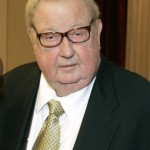Robert Drew passed away July 30 at the age of 90. Most people have never heard of him but he had a major effect on modern cinema.
Robert Drew is credited for inventing the modern form of what might be called direct cinema, Cinema verete, or observational cinema. Before Drew, documentary films existed but they mostly featured talking heads. In those days documentaries were thought of as educational films. Documentaries were informative, but boring. One problem: heavy, bulky cameras made shooting difficult.
Drew was working at “Life Magazine” and got one of those prestigious Neiman fellowships, which sent him to Harvard, to study how he could make a reality film more interesting. In an interview in 1962, Drew said he was looking for a form of documentary that would “drop word logic and find a dramatic logic in which things really happened.” It would be “a theater without actors; it would be plays without playwrights; it would be reporting without summary and opinion; it would be the ability to look in on people’s lives at crucial times from which you could deduce certain things and see a kind of truth that can only be gotten from personal experience.”
After his fellowship, he formed Drew and Associates, and set about putting his vision into practice. He needed two things to get the films he envisioned: Smaller cameras and cameramen who could get what he was looking for. His ideas hit at the right time. Smaller cameras could be adapted to help make a shooter less obtrusive. These cameras (like all 16 mm cameras) shot 11 minutes of film and then need to be reloaded.
Drew also got a crew that went on to become the all-stars of early documentary filmmaking. Al and David Maysles, D.A. Pennebaker and Richard Leacock. Drew’s revolutionary idea was that the camera and sound men (they were mostly men in those days) would observe what they saw, be a fly on the wall, shoot a ton of film, and find the drama in the editing. It would be heresy to ask a subject to move or repeat a line. This is a far cry from today’s reality TV or Ken Burns’ films or contemporary films that have animation and re-creations. Robert Drew got us to see what was there; there was a pureness in that.
His major work included “Primary,” which followed JFK in his bid to win the Wisconsin primary. It is the first political film where you really see what is happening. We observe Kennedy having his picture taken, talking at a rally and waiting for the results. We had never witnessed these moments before so closely, so intimately.
https://vimeo.com/ondemand/18541/68806395
His next hit was “Crisis: Behind a Presidential Commitment (1963)” which followed the crisis of two African Americans trying to enroll in the University of Alabama. It followed JFK in the white house and George Wallace in the governor’s mansion. It had high drama, a story unfolding in front of the audience. Documentary films had not done this before. There is a great moment in “Crisis” where Bobby Kennedy, at home in Washington, is talking on the phone to Nicholas Katzenbach, his assistant attorney general in Alabama. It was amazing that cameramen were able to get it. The two are talking about the problem when one of Bobby’s kids picks up the phone and asks Katzenbach what the weather is like there – a real human moment in the middle of a crisis.
https://www.youtube.com/watch?v=eFp1JZ5qSnM&list=PL0O5WNzrZqIMUXlOqDYq423XHJbygpllj&index=4
Another of Drew’s great films was “Faces in November,” a short film of the memorial after Nov. 22, 1963. While other people were shooting the action and the majestry of DC, Drew’s cameramen only shot close-ups of everyday people showing their pain.
Over the years many critics and filmmakers have treasured Drew’s contribution to cinema, but to the public, he is mostly unknown. This has to do with the cult of the director. Drew was not a director or shooter; he was a producer. His disciples did go on to fame. The Maysles made “Salesman,” “Grey Gardens”and many other important works. D. A. Pennebaker (known ans Penny) went on to make “Don’t Look Back,” “Monterrey Pop,” and “The War Room” among others. The basic aesthetic principal for all these films comes from Drew.
He will be missed.






0 Comments